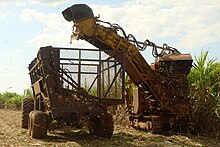
The history of ethanol fuel in Brazil dates from the 1970s and relates to Brazil's sugarcane-based ethanol fuel program, which allowed the country to become the world's second largest producer of ethanol, and the world's largest exporter.[1] Several important political and technological developments led Brazil to become the world leader in the sustainable use of bioethanol,[2][3][4][5] and a policy model for other developing countries in the tropical zone of Latin America, the Caribbean, and Africa.[6][7][8] Government policies and technological advances also allowed the country to achieve a landmark in ethanol consumption, when ethanol retail sales surpassed 50% market share of the gasoline-powered vehicle fleet in early 2008.[9][10] This level of ethanol fuel consumption had only been reached in Brazil once before, at the peak of the Pró-Álcool Program near the end of the 1980s.[9][10][11]
- ^ "Industry Statistics: Annual World Ethanol Production by Country". Renewable Fuels Association. Archived from the original on 2008-04-08. Retrieved 2008-05-02.
- ^ Daniel Budny and Paulo Sotero, ed. (April 2007). "Brazil Institute Special Report: The Global Dynamics of Biofuels" (PDF). Brazil Institute of the Woodrow Wilson Center. Archived from the original (PDF) on 2008-05-28. Retrieved 2008-05-03.
- ^ Inslee, Jay; Bracken Hendricks (2007). Apollo's Fire. Island Press, Washington, D.C. pp. 153–155, 160–161. ISBN 978-1-59726-175-3. . See Chapter 6. Homegrown Energy.
- ^ Larry Rother (2006-04-10). "With Big Boost From Sugar Cane, Brazil Is Satisfying Its Fuel Needs". The New York Times. Retrieved 2008-04-28.
- ^ "Biofuels in Brazil: Lean, green and not mean". The Economist. 2008-06-26. Retrieved 2008-11-28.
- ^ Thomas L. Friedman (2008). Hot, Flat, and Crowded. Farrar, Straus and Giroux, New York. p. 190. ISBN 978-0-374-16685-4. The author considers that ethanol can be a transport solution for Brazil, but one that only can be replicated in other tropical countries, from Africa to the Caribbean.
- ^ Hausmann, Ricardo; Rodrigo Wagner (October 2009). "Certification Strategies, Industrial Development and a Global Market for Biofuels". Belfer Center for Science and International Affairs and Sustainability Science Program, Center for International Development, John F. Kennedy School of Government, Harvard University. Archived from the original on 2010-01-22. Retrieved 2010-02-09. Discussion Paper 2009-15. The authors found that for some countries in Central Africa and Latin America ethanol can represent a large industry, at least relative to current exports. The list of the relative importance of biofuels (sugarcane ethanol in particular and replicating the Brazilian production system) is headed by Suriname, Guyana, Bolivia, Paraguay, DR of Congo, and Cameroon. See pp. 5–6
- ^ Mitchell, Donald (2010). Biofuels in Africa: Opportunities, Prospects, and Challenges. The World Bank, Washington, D.C. pp. xix–xxxii. ISBN 978-0-8213-8516-6. See Executive Summary and Appendix A: The Brazilian Experience.
- ^ a b Cite error: The named reference
ANP07_2008was invoked but never defined (see the help page). - ^ a b Cite error: The named reference
50consumowas invoked but never defined (see the help page). - ^ Cite error: The named reference
ANP02_2008was invoked but never defined (see the help page).
© MMXXIII Rich X Search. We shall prevail. All rights reserved. Rich X Search
